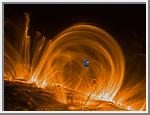|
COMETS EARTH JUPITER KUIPER BELT MARS MERCURY METEORITES NEPTUNE OORT CLOUD PLUTO SATURN SOLAR SYSTEM SPACE SUN URANUS VENUS ORDER PRINTS
PHOTO CATEGORIES SCIENCEVIEWS AMERICAN INDIAN AMPHIBIANS BIRDS BUGS FINE ART FOSSILS THE ISLANDS HISTORICAL PHOTOS MAMMALS OTHER PARKS PLANTS RELIGIOUS REPTILES SCIENCEVIEWS PRINTS
|
Related Document
Download Options
Fountains of multimillion-degree, electrified gas in the atmosphere of the Sun have revealed the location where the solar atmosphere is heated to temperatures 300 times greater than the Sun's visible surface. Scientists discovered this important clue for solving the long-standing mystery of the hot solar atmosphere while observing the gas fountains (known as coronal loops) in unprecedented detail with NASA's Transition Region and Coronal Explorer (TRACE) spacecraft. Scientists are interested in the Sun's outer atmosphere, called the corona, because eruptive events occurring in this region can disrupt high-technology systems on Earth. Moreover, studies of the solar corona will help astronomers better understand other stars, which cannot be observed in as fine detail as the Sun. The new observations reveal the location of the unidentified energy source, showing that most of the heating occurs low in the corona, within about 10,000 miles (16,000 kilometers) from the Sun's visible surface. The gas fountains form arches (some more than 300,000 miles high and capable of spanning 30 Earths) as gas emerges from the solar surface, is heated and rises while flowing along the solar magnetic field, then cools and crashes back to the surface at more than 60 miles per second (100 kilometers per second). Millions of different-sized arches, called coronal loops, comprise the corona, and a 30-year old theory assumes that the loops are heated evenly throughout their height. The TRACE observations show that instead, most of the heating must occur at the bases of the coronal loops, near where they emerge from and return to the solar surface. This image is a false color picture of ultraviolet light emitted by the hot gas that comprises the coronal loops. Ultraviolet light is invisible to the human eye, but detectable by the special instruments on board TRACE. White represents the brightest ultraviolet light. Earth is shown as a comparison. For images and more information on the Internet, visit: Views of the Solar System's Sun Page. |
